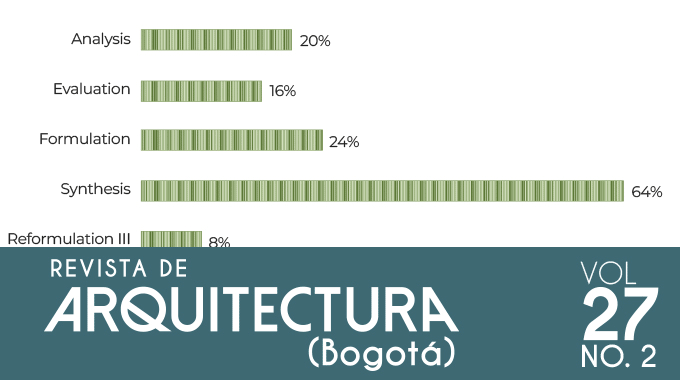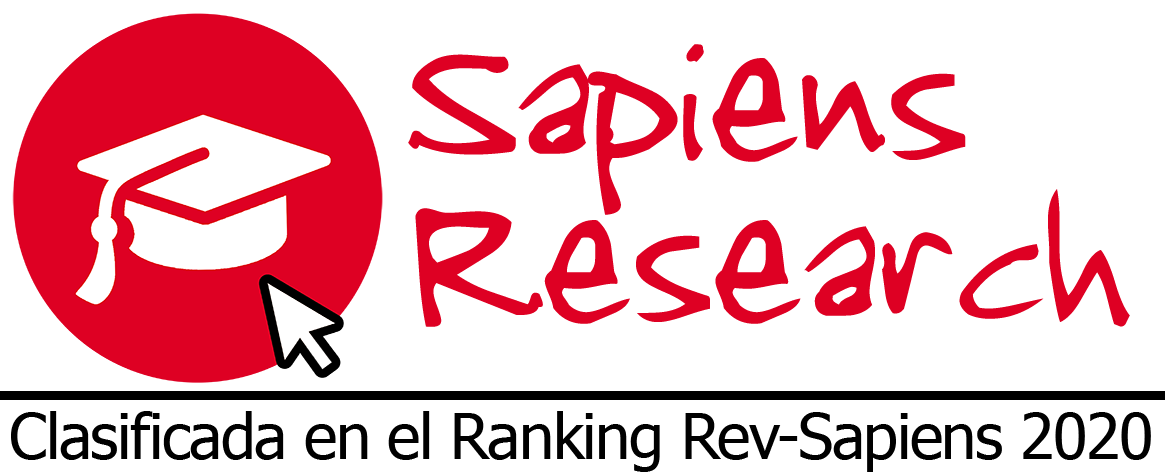

This work is licensed under a Creative Commons Attribution-NonCommercial 4.0 International License.
Revista de Arquitectura is an open access journal. More information...
Authors retain copyright and grant to the Revista de Arquitectura the right of first publication, which will be simultaneously subject to the Creative Commons (CC) BY-NC license.
Authors will sign a non-exclusive distribution license for the published version of the article by completing (RevArq FP03 Permission to Reproduce).
Self-archiving will comply with SHERPA/RoMEO guidelines and the Green classification.
To see in detail these guidelines, please consult...
Abstract
This research explores the relationship between creativity and cognitive actions in a design process that cause conceptual expansion and shift to understand how creative insights develop. The research was conducted with 25 participants using the think-aloud protocol who were given a design problem to solve. Linkographic entropies were obtained from the verbal data of design sessions to determine critical moves (CM) and their associated design decisions. CM networks were then coded using Function-Behaviour-Structure (FBS) ontology to determine design actions, and semantic analysis was used to determine the design transformation types.
The results showed that conceptual shift is only achieved through Synthesis, while conceptual expansions serve as a base for conceptual shifts. Cognitive actions such as reformulations and evaluations were found to cause conceptual expansions and contribute to conceptual shifts at different levels. The distance between knowledge sets used during cognitive actions influences the effectiveness and types of conceptual transformations. The research concludes that Formulation and Analysis do not contribute to conceptual transformations. The research provides insights into the cognitive processes underlying design creativity and can inform design education and practice.

References
Ashrafganjouei, M. & Gero, J. S. (2021). Exploring the effect of a visual constraint on students’ design cognition. Artificial Intelligence for Engineering Design, Analysis and Manufacturing, 35(1), 3-19. https://doi.org/10.1017/S0890060420000335
Boden, M. (1995). Creativity and unpredictability. Stanford Humanities Review, 4(2), 123-139. https://dl.acm.org/doi/10.5555/212154.212171
Boden, M. A. (1998). Creativity and artificial intelligence. Artificial Intelligence, 103(1), 347-356.https://doi.org/10.1016/S0004-3702(98)00055-1
Chiu, I. & Shu, L. H. (2012). Investigating effects of oppositely related semantic stimuli on design concept creativity. Journal of Engineering Design, 23(4), 271-296. https://doi.org/10.1080/09544828.2011.603298
Cross, N. (1997a). Creativity in design: analyzing and modelling the creative leap. Leonardo, 30(4), 311–317. https://doi.org/10.2307/1576478
Cross, N. (1997b). Descriptive models of creative design: Application to an example. Design Studies, 18(4), 427–455. https://doi.org/10.1016/S0142-694X(97)00010-0
Cross, N. (2006). Designerly Ways of Knowing. Springer.
Cross, N. (2008). Engineering design methods: Strategies for product design (4th ed.). John Wiley& Sons.
Ericsson, K. A. (1998). The Scientific Study of Expert Levels of Performance: general implications for optimal learning and creativity. High Ability Studies, 9(1), 75-100. https://doi.org/10.1080/1359813980090106
Ericsson, K. A. (2006). Protocol Analysis and Expert Thought: Concurrent Verbalizations of Thinking during Experts’ Performance on Representative Tasks. In K. A. Ericsson, N. Charness, P. J. Feltovich, & R. R. Hoffman (Eds.), The Cambridge Handbook of Expertise and Expert Performance (pp. 223–242). Cambridge: Cambridge University Press. https://doi.org/10.1017/CBO9780511816796.013
Fakhra, A. J. (2012). Conceptual model of design creativity: Fostering creative cognition in architecture and design pedagogy (Order No. 3570129) [Doctoral dissertation, Illinois Institute of Technology]. ProQuest Dissertations & Theses Global. Finke R. A., Ward T. B. & Smith S. M. (1992). Creative Cognition: Theory, Research, and Applications. MIT Press. https://doi.org/10.7551/mitpress/7722.001.0001
Fu, K., Chan, J., Cagan, J., Kotovsky, K., Schunn, C. & Wood, K. (2013). The meaning of “near” and “far”: the impact of structuring design databases and the effect of distance of analogy on design output. Journal of Mechanical Design, 135(2). https://doi.org/10.1115/1.4023158
Gero, J. & Kannengiesser, U. (2007). A function–behavior–structure ontology of processes. Artificial Intelligence for Engineering Design, Analysis and Manufacturing, 21(4), 379-391. https://doi.org/10.1017/S0890060407000340
Gero, J. S. (1990). Design prototypes: A knowledge representation schema for design. AI Magazine, 11(4), 26-36. https://doi.org/10.1609/aimag.v11i4.854
Gero, J. S. & Milovanovic, J. (2020). A framework for studying design thinking through measuring designers’ minds, bodies and brains. Design Science, 6, e19. https://doi.org/10.1017/dsj.2020.15
Goel, V. (1995). Sketches of Thought. Cambridge. MIT Press. https://doi.org/10.7551/mitpress/6270.001.000
Goldschmidt G. (2014). Linkography: Unfolding the design process. MIT Press. https://doi.org/10.7551/mitpress/9455.001.0001
Gursoy, B. (2010). The cognitive aspects of model-making in architectural design. [Master’s thesis, Middle East Technical University]. OpenMETU https://open.metu.edu.tr/handle/11511/19344
Hampton, J. A. (1987). Inheritance of attributes in natural concept conjunctions. Memory and Cognition, 15, 55–71. https://doi.org/10.3758/BF03197712
Ho, C. H. (2001). Some phenomena of problem decomposition strategy for design thinking: differences between novices and experts. Design Studies, 22(1), 27-45. https://doi.org/10.1016/S0142-694X(99)00030-7
Hocking, I. & Vernon, D. (2017) A bridge too far: conceptual distance and creative ideation. Creativity: Theories, Research, Applications, 4(2), 333-352. https://doi.org/10.1515/ctra-2017-0017
Jia, L., Becattini, N., Cascini, G. & Tan, R. (2020). Testing ideation performance on a large set of designers: effects of analogical distance. International Journal of Design Creativity and Innovation, 8(1), 31-45. https://doi.org/10.1080/21650349.2019.1618736
Kan, J. W. T. & Gero, J. S. (2009). Using the FBS Ontology to Capture Semantic Design Information in Design Protocol Studies. In J. McDonnell, & P. Lloyd (Eds.), About: Designing. Analysing Design Meetings (pp. 213-229). CRC Press. https://doi.org/10.1201/9780429182433-16
Kaya, A. N. & Cikis, S. (2017). Links between creative performance and post-formal thought. Creativity. Theories–Research-Applications, 4(1), 116-136. https://doi.org/10.1515/ctra-2017-0006
Koestler, A. (1964). The act of creation. Arkana/Penguin.
Monache, S. D. & Rocchesso, D. (2016, October 4-6). Cooperative sound design: A protocol analysis [Paper presentation]. AM ‘16: Audio Mostly 2016. https://doi.org/10.1145/2986416.2986424
Noushad, B., Van Gerven, P. W. M. & de Bruin, A. B. H. (2023). Twelve tips for applying the thinkaloud method to capture cognitive processes. Medical Teacher, 46(7), 892–897. https://doi.org/10.1080/0142159X.2023.2289847
Sawyer, R. K. (2006). Explaining Creativity: the science of human innovation. Oxford University Press. https://doi.org/10.1093/oso/9780195161649.001.0001
Schön, D. A. (1983). The Reflective Practitioner: How Professionals Think in Action. Basic Books.
Shih, Y. T. & Sher, W. (2020). Designers’ Reflections on Two Methods of Using Design Media for Learning Design Processes. Computer-Aided Design and Applications, 17(6), 1215-1228. https://doi.org/10.14733/cadaps.2020.1215-1228
Someren, M., Barnard, Y. & Sandberg, J. (1994). The Think Aloud Method: A Practical Guide to Modelling Cognitive Processes. Academic Press.
Tang, H., Chen, Y., and Gero, J. (2012) The Influence of Design Methods on the Design Process: Effect of use of scenario, brainstorming, and synectics on designing, in Israsena, P., Tangsantikul,J. and Durling, D. (eds.), Research: Uncertainty Contradiction Value - DRS International Conference 2012, 1-4 July, Bangkok, Thailand. https://dl.designresearchsociety.org/drs-conference-papers/drs2012/researchpapers/134
van der Lugt, R. (2001) Sketching in design idea generation meetings, [PhD dissertation, Delft University of Technology]. TU Delft Repository. https://resolver.tudelft.nl/uuid:7bd2639b-26ef-4550-8675-94bda367a102
van der Lugt, R. (2003, August 19-21). Relating the quality of the idea generation process to the quality of the resulting design ideas [Paper presentation]. DS 31: Proceedings of ICED 03, the 14th International Conference on Engineering Design.
Wan, W. & Chiu, C. Y. (2002). Effects of novel conceptual combination on creativity. Journal of Creative Behaviour, 36, 227–241. https://doi.org/10.1002/j.2162-6057.2002.tb01066.x
Ward, T. B., Patterson, M. J., Sifonis, C. M., Dodds, R. A. & Saunders, K. N. (2002). The role of graded category structure in imaginative thought. Memory and Cognition, 30, 199–216. https://doi.org/10.3758/BF03195281
Ward, T. B., Smith, S. M. & Vaid, J. (1997). Conceptual structures and processes in creative thought. In T.B. Ward, S. M. Smith, & J. Vaid (Eds.), Creative thought: An investigation of conceptual structures and processes (pp. 1–27). American Psychological Association. https://doi.org/10.1037/10227-001
Warr, A. M. (2007). Understanding and supporting creativity in design [Doctoral dissertation, University of Bath]. The University of Bath’s research portal. https://researchportal.bath.ac.uk/en/studentTheses/understanding-and-supporting-creativity-in-design
































